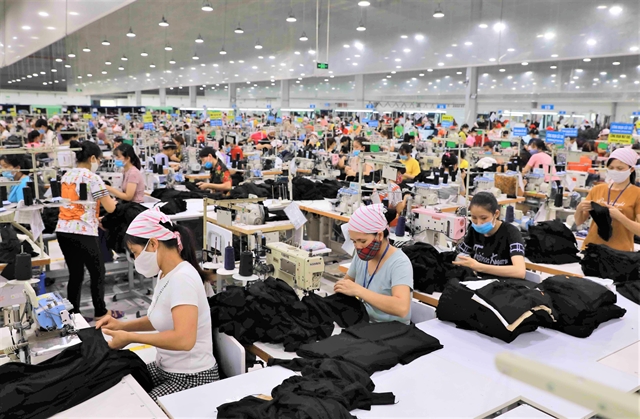 Society
Society

Most industries impacted by COVID-19 pandemic have shown “signs of recovery” in the third quarter, with better job situation and workers’ income in this period compared to the second quarter but not as good as last year’s third quarter.

|
| Female workers at the South Korean-invested Yakjin Co Ltd specialised in knitwear for export to the US. — VNA/VNS Photo Vũ Sinh |
HÀ NỘI — As of September, 31.8 million above-15-year-old labourers in Việt Nam were negatively affected by the COVID-19 pandemic with either job losses, reduced working hours and income or rotational leave, according to the country’s statistics bureau on Tuesday.
Up to 68.9 per cent of the workers reported lower income, 40 per cent suffered cuts to working hours or were put on temporary rotational leave, while 14 per cent lost their jobs or were furloughed indefinitely, the General Statistics Office (GSO) of Việt Nam said during a press briefing on the labour situation in the country in the third quarter held this morning in Hà Nội.
Head of GSO Nguyễn Thị Hương said that most industries impacted by the COVID-19 pandemic had shown “signs of recovery” in the third quarter, with better job situation and workers’ income in this period compared to the second quarter but not as good as last year’s third quarter.
The total workforce of the country as of the third quarter of 2020 reached 54.6 million, up 1.4 million compared to the second quarter where a record drop was recorded as the country started enforcing border closures and nationwide lockdowns to combat the spread of the coronavirus.
While this represents a “recovery of the workforce,” GSO noted that the number still fell short of the third quarter last year by 1.1 million.
The drop was highest in rural areas, Vũ Thị Thu Thuỷ, head of GSO’s population and labour statistics department, said.
During 2016-19, on average, within the first nine months of the year, the country’s workforce rose 1 per cent compared to the same period the year before.
Without COVID-19 and provided that the same rate is applied in 2020, the economy could have had 1.8 million more workers by this time, Thuỷ said.
“In other words, the coronavirus pandemic might have stripped 1.8 million people of the chance to work this year,” she added.
As many as 1.2 million people in Việt Nam lost their jobs, down 63,000 from the second quarter but still 148,200 higher than last year.
The service sector was the hardest hit by the pandemic, with nearly 70 per cent of the workers in this sector affected, followed by 66.4 per cent of the workers in the industrial and construction sector.
Việt Nam’s agriculture, forestry and fisheries sector fared better with only 27 per cent of the workforce impacted by the pandemic.
Some hardest hit industries include entertainment and arts, with 88.6 per cent of workers affected, followed by hospitality and food and beverages (81.7 per cent), transportation and storage (79.7 per cent), administrative and supporting services (72.7 per cent), processing and manufacturing (70.1 per cent), automobile wholesale and retail and repairs (68.5 per cent), education and training (68.5 per cent), and real estate activities (67.8 per cent), according to the GSO.
With the resumption of most of socio-economic activities, workers’ income in the third quarter also saw an improvement compared to the second quarter but still paled in comparison to the same period last year.
Average monthly income in the third quarter of 2020 reached VNĐ5.5 million (US$238), up VNĐ258,000 compared to the second quarter but VNĐ115,000 lower than last year.
Average monthly income of male workers was 1.4 times higher than that of female workers (VNĐ6.3 million and VNĐ4.6 million, respectively), GSO reported.
The average income of workers in urban areas was 1.5 times higher than that in rural areas (VNĐ7 million and VNĐ4.8 million, respectively).
Overall, in the first nine months of 2020, the average income of employees decreased by 1.5 per cent – about VNĐ83,000 – over the same period last year.
The income of workers in most industries decreased; of which, the largest cuts were seen in administrative activities and support services (down by 6.5 per cent), accommodation and food services (5.9 per cent), and transportation (4.9 per cent).
Meanwhile, some industries have reported increased income – information and communications, up 1.7 per cent, and health and social assistance, up 3.3 per cent.
Overall, in the first nine months of 2020, rural workers and female workers were still the groups most significantly affected by the impact of the COVID-19 pandemic with the decrease in the labour force of these two groups compared to the same period last year being 3.2 per cent and 2.3 per cent, respectively.
Average monthly income of informal sector workers in the first nine months of 2020 was VNĐ5.5 million, 1.5 times lower than the monthly average income of those in the formal sector (VNĐ8.4 million).
Compared to the same period last year, the monthly average income of formal sector workers decreased by 1.9 per cent, while the income of informal sector workers went down by 0.8 per cent.
GSO’s report also noted that specific support packages should be developed to target vulnerable groups – such as female workers, workers with no technical expertise or those in informal sectors – to help them find jobs and contribute to the national economic recovery efforts, alongside stimulus packages and policies supporting businesses and production establishments in the hardest hit industries.
While Việt Nam is one of the few economies in the world to report positive GDP growth in the third quarter, with the COVID-19 situation largely under control, but the 2.62 per cent increase marks a historic low not previously seen in the 2011-20 period. — VNS




